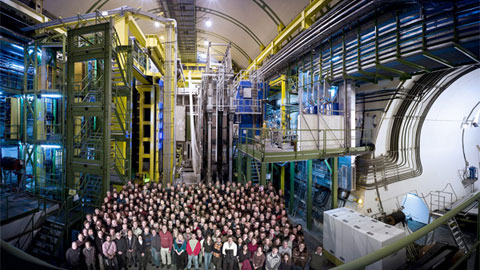LHC confirms an anomaly that could suggest the existence of a new particle

26/03/2015
The Standard Model, which has given the most complete explanation up to now of the universe (until the discovery of the Higgs boson), contains gaps and is unable to explain phenomena like dark matter or gravitational interaction between particles. Physicists are therefore seeking a more fundamental theory that they call "New Physics", but up to now there has been no proof of its existence, only indirect observation of dark matter, as deduced from the movement of the galaxies.
A team of physicists formed by J. Virto (Universität Siegen, Germany), L. Hofer (UAB), S. Descotes-Genon (LPT-Paris, France) and UAB professor of the Department of Physics Joaquim Matias, predicted in 2013 that this New Physics implied the existence of deviations in the probability of a very specific disintegration of a particle, the B meson. If these small deviations could be detected experimentally it would be the first proof of this more fundamental theory.
In July 2013, at the EPS 2013 international conference on particle physics in Stockholm, scientists at the LHCb detector, one of the large experiments being conducted by the CERN's LHC accelerator, presented the results of the experimental disintegration measurements of the B meson. The measurements show deviation in comparison to the predictions of the Standard Model, anomalies and tensions which could be explained by the hypothesis that New Physics modified the Standard Model predictions in a very specific manner, as UAB researchers had calculated. Nevertheless, more measurements needed to be taken, given that the probability were relatively high that those deviations were the result of chance and not of theoretical predictions.
At the recently held annual meeting of Particle Physics, in the town La Thuile in the Italian Alps, which took place on 14 and 21 March 2015, a team of physicists from the CERN LHCb detector presented the latest results of the new experiments conducted on the disintegration of the B meson. It is worth highlighting the difficulty of the experimental analysis conducted by the LHCb, involving the introduction of new techniques and the expertise of brilliant scientists (contact researchers are N. Serra, K. A. Petridis and C. Langenbruch). The data presented now with much more statistics confirms the deviation pattern observed in the previous measurements. Researchers point to the fact that the class of New Physics models capable of explaining these results postulate the existence of a new particle labelled Z'.
For Joaquim Matias, “we are now in the first stage, i.e., we are confirming the deviations with a greater amount of statistics. The analysis of this data, together with other channels also showing deviations, gives a result of more than 4 sigmas; in a parallel study by the group formed by W. Altmannshofer and D. Straub, a very similar pattern was observed. We are now in the data observation phase and there are two possibilities. Either we are observing New Physics, or this is a hadronic conspiracy within the Standard Model generating the deviations observed. The hard work is clearly establishing this difference, and that requires time and more data.” “The work conducted at LHCb and the theoretical groups does not end here and more analysis using different techniques, and with more data, can help to clarify the great question about whether we are observing New Physics or not,” Matias concludes.
More information:
Article by Joaquim Matias:
Confirmation of the anomaly observed at LHCb: New Physics or hadronic conspiracy?